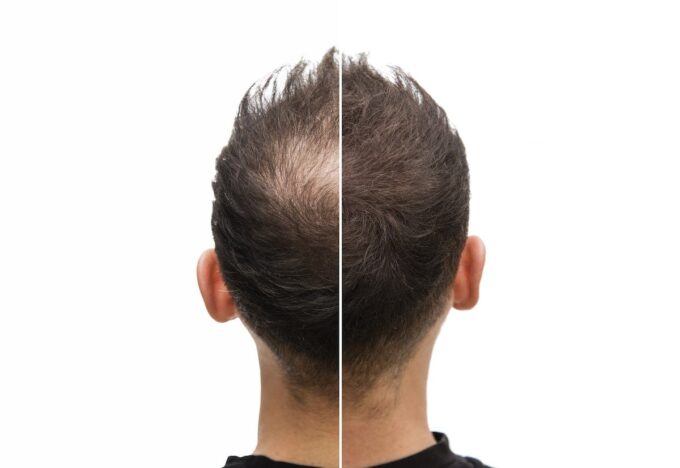Hair loss is a common problem faced by both men and women. According to a Newswire article, around 775,000 Canadians are affected by alopecia areata at some time in their life. Alopecia areata can result in hair loss as it impacts the hair follicles. Most people start to show these symptoms in their teenage years and 30s. Several other reasons include genes, hormonal changes, stress, etc.
However, the good news is that there are enough treatments, too. The array of treatments, from topical solutions to surgical procedures, can be overwhelming.
Among these options, scalp micropigmentation (SMP) has emerged as a promising alternative, offering a non-invasive and effective solution. However, weighing the pros and cons of SMP against other hair loss treatments is essential to make an informed decision.
Understanding Scalp Micropigmentation (SMP)

Source: medium.com
Scalp micropigmentation is a non-surgical cosmetic procedure. You can think of it as a customized, specially created tattoo. It involves the application of pigments to the scalp to create the illusion of a closely cropped hairstyle or a fuller head of hair.
Unlike traditional tattooing, SMP uses specialized equipment and techniques to replicate the appearance of natural hair follicles. The procedure is performed by trained technicians who meticulously deposit pigment into the scalp’s upper dermis. This creates tiny dots that resemble hair follicles.
As stated in a study published in ResearchGate, multiple treatments may be required for a layered look. A full head SMP may require 20–30 hours to complete. However, SMP results last for a long time, with minimal touch-ups required at regular intervals.
If you want to get scalp micropigmentation, it is vital to consider a local technician. As stated above, scalp micropigmentation may require touch-ups after a few years. If you go for a technician who lives far away, you might have to visit him or her for these touch-ups. This can result in loss of time and money. On the other hand, a local technician will be easily available for any help you want regarding the scalp micropigmentation procedure.
Getting scalp micropigmentation done can help prevent the appearance of baldness. Consider the example of Canada, where many people suffer from alopecia areata. Suppose you live in a city like Toronto in Canada. In that case, you can look for scalp micropigmentation in Toronto online to find a local technician.
Comparing SMP with Other Hair Loss Treatments
Besides SMP, there are many other hair loss treatments available, including hair transplantation, topical treatments, and laser treatment.
Hair Transplantation
The process of hair transplantation involves surgery. Hair follicles from donor areas are harvested and transplanted into balding or thinning areas. Usually, the back sides of the scalp serve as the donor areas. Even though hair transplantation can produce results that look natural, it involves invasive surgery and may need a long recovery period.
One of the primary differences between SMP and hair transplantation is the invasiveness of the procedures. SMP is non-surgical and does not involve incisions or the removal of hair follicles from donor areas. Hence, SMP carries fewer risks and complications than hair transplantation, making it a safer option for individuals hesitant to undergo surgery.
Additionally, SMP is suitable for individuals who may not be ideal candidates for hair transplantation due to insufficient donor hair or medical contraindications. SMP does not rely on existing hair follicles for transplantation. Therefore, it can provide a viable solution for individuals with limited donor hair.
Hair transplants offer a more lasting result. In fact, hair transplantation can also yield permanent results. On the other hand, SMP requires regular touch-up sessions, usually at intervals of 3-5 years. However, this is also reflected in the costs of these procedures. According to Statista, the total cost of a hair transplant in Canada was around $17,500 in 2020 and 2021. This is quite expensive as compared to SMP.
Laser Treatments

Source: majesticderma.com
Laser treatments for hair loss utilize low-level laser therapy (LLLT) devices to stimulate hair follicles and encourage hair regrowth. By delivering targeted light energy to the scalp, these treatments purportedly enhance blood flow and cell metabolism in the hair follicles. Laser therapy is non-invasive and painless, making it an attractive option for individuals wary of surgical procedures or chemical treatments.
One significant difference between SMP and laser treatments lies in their longevity and maintenance requirements. SMP offers a semi-permanent solution to hair loss, with results typically lasting several years before requiring touch-up sessions to maintain optimal appearance.
In contrast, laser treatments often necessitate ongoing sessions over an extended period to sustain hair regrowth. Moreover, the results of laser treatments vary depending on individual response to treatment and the severity of hair loss.
Cost is another factor to consider when comparing SMP and laser treatments. While the initial cost of SMP may be higher due to the specialized equipment and expertise required, it offers a one-time investment for semi-permanent results. Laser treatments, on the other hand, may require multiple sessions spread out over time, potentially increasing the overall cost of treatment.
Topical Treatments

Source: everydayhealth.com
Topical treatments, such as minoxidil (Rogaine) and finasteride (Propecia), commonly treat hair loss by promoting hair growth and preventing further thinning. These treatments are typically applied directly to the scalp and are available over the counter or by prescription.
An article from the Canadian Alopecia Areata Foundation states how these treatments work. The article says that they work by widening the skin’s blood vessels and extending the hair’s growth phase. This allows better blood flow to the hair follicles, stimulating hair growth.
While topical treatments can be effective for some individuals, they often require long-term usage and may produce varying results. Unlike SMP, which provides immediate and predictable outcomes, topical treatments may take months to show noticeable improvements, and their efficacy can diminish over time.
Another consideration is the convenience of treatment. Topical solutions require regular application and adherence to a strict regimen, which may be inconvenient for individuals with busy lifestyles. In contrast, SMP offers a one-time solution requiring minimal maintenance, allowing individuals to enjoy long-lasting results without daily applications.
In conclusion, scalp micropigmentation offers a compelling alternative to traditional hair loss treatments. It provides immediate results, minimal maintenance, and a non-invasive approach to restoring the appearance of a fuller head of hair.
While other treatments have their merits, they may not suit everyone due to their invasive nature, long-term commitments, or potential side effects. Ultimately, the choice between scalp micropigmentation and other hair loss treatments depends on individual preferences, lifestyle factors, and desired outcomes.






